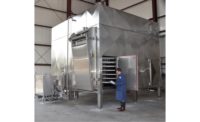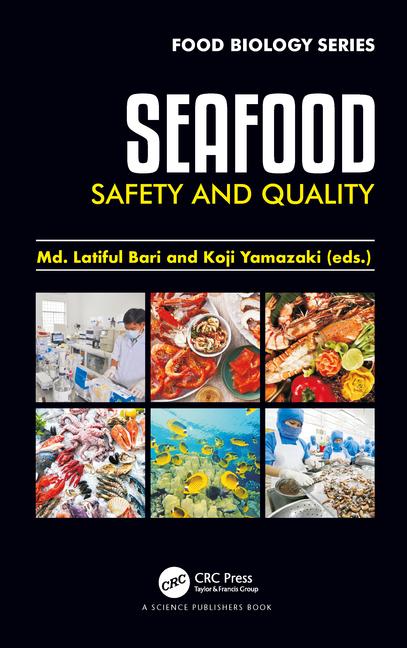An Enlightening Food-Safety Tool
by Lynn Petrak,
Special Projects Editor
Special Projects Editor
Refined technology, improved instrumentation are hallmarks of the latest in ATP bioluminescence testing.
When it comes to bringing food-safety problems to light, one method accomplishes that purpose in a literal way. Adenosine triphosphate (ATP) bioluminescence testing, which identifies potential contaminants by detecting light emitted from living organisms, has been used by processors for several years and has evolved in recent times to include more sophisticated instruments, affordable options, and quicker, accurate results.
Technology concept
The concept behind ATP technology is basic: ATP is a molecule that is essential and common to all plant, animal, and microbial cells. It is a highly-stable compound that combines and reacts with an enzyme resulting in the release of light. Viable microorganisms on the surface of animal carcasses, including harmful microorganisms like Listeria monocytogenes, Salmonella, and E. coli O157:H7 among others, release ATP and convert chemical energy to light energy, which is detected by specially-designed instruments. The measurement of biological contamination is done by determining the amount of ATP contained within or on the material.
“ATP is present in either metabolically viable cells or cells that have just ruptured and released ATP in the surrounding environment,” explains Rocelle Clavero, Ph.D., technical director for Silliker Inc., Homewood, IL, a global provider of laboratory testing services.
Surfaces that may be contaminated with bacteria are swabbed and checked with instruments called luminometers, which read emitted levels of ATP in measurements of relative light units (RLUs). Clavero says that several ATP systems are commercially available and operate on the same principle, with slight variations.
“All luminometers measure the amount of light emitted by the ATP-luciferin-luciferase reaction, but differ on the internal setting of the ‘pass/fail’ criteria, type of neutralizer and enzyme mix, use of kinetic-altering substances, and test instrument design,” she says. “The luminometer settings, therefore, can affect the reporting of test results and utility of the generated data for trend analysis. Proper selection of appropriate ATP systems is essential to obtain the desired results for its intended application.”
In a meat and poultry processing plant, ATP testing is used as part of a multi-hurdle approach to food safety, along with other detection and evaluation methods. “It is not the stopgap to everything, but it is part of your whole sanitation program,” remarks Sandra Bull, senior market manager for St. Paul, MN-based Ecolab Inc., a provider of an extensive line of sanitation products and a distributor ATP testing tools from Lawrence, MA-based manufacturer Charm Sciences Inc.
Typically, ATP testing falls under sanitation or quality-assurance functions. “The meat and poultry industry uses rapid ATP detection systems to quickly assess the hygienic status of surfaces after cleaning and before processing begins. It is a quick way to verify SSOPs,” explains Steven Nason, vice president of marketing for ATP testing supplier Hygiena, Camarillo, CA. “They also use ATP systems to troubleshoot within facilities to find out where contamination could be happening.”
Anita Kressner, director of sales and marketing for technology provider BioControl Systems Inc., Bellevue, WA, agrees that the ATP bioluminescence testing is a key component of many preventative safety initiatives. “ATP has been used for many years, and has become the mainstay of many businesses in this industry and other industries. As a tool for verifying pre-operation sanitation, it is indispensable,” she says.
The technology may not be new, but it is being used more extensively and in different ways by processors, according to Jim Topper, marketing manager for Lansing, MI-based testing supplier Neogen Corporation.
“The value of ATP is you find out the results immediately — within twenty seconds you know if you need to call back the cleaning crew,” Topper observes.
Meat and poultry plants are unique in the food manufacturing sector because there are so many areas vulnerable to contamination — some processors have identified hundreds of potential hot spots. “The principle is that you don’t just use it on obvious surfaces, but also in nooks, crannies, and crevices,” says Kressner, who recommends testing both direct and indirect contact surfaces on a random and rotating basis, from cutting areas to conveyor belts to non-contact areas like floors, drains, and light figures. “It’s basically anywhere you can cross-contaminate products,” she notes.Bioluminescence bonuses
Experts on the technology say there are many benefits to using this technology. “ATP bioluminescence testing has proven to be an effective, real-time tool that allows food-plant personnel to correct sanitation deficiencies on food-contact surfaces prior to the start of production,” Clavero says.
Nason compares the technology to the more expensive, labor-intensive, and time-consuming task of standard environmental swabbing, which provides results as late as four days later. “With a rapid ATP sanitation monitoring program in place, you know in fifteen seconds if something is on the surface,” he points out. “ATP systems give meat processors the ability to quickly, easily, and accurately monitor cleaning standards before production starts. This helps ensure lower levels or no microorganisms in product, stop cross-contamination, improve shelf life, and decrease the risk of recalls.”
ATP bioluminescence testing is also an important component of today’s far-reaching food-safety and quality-control measures in meat and poultry plants, such as Hazard Analysis Critical Control Point (HACCP) systems and traceability programs. “Those are things for which people are developing advanced manufacturing solutions. With a punch of a button, you can do all the traceability on a product, back to the sanitation manager cleaning up on a particular night,” comments Nason.
Although ATP bioluminescence testing offers several advantages, it is not an exact science when it comes to pathogen identification. “While there is real benefit to using of ATP testing for pre-operational inspection, it does not provide an accurate assessment of microbial numbers present on food-contact surfaces or absence of risk due to the presence of food-borne pathogens. As a result, ATP testing should be used in conjunction with microbial testing of the environment,” Clavero suggests.
Nason agrees. “ATP testing is not specific to microbial contamination. ATP systems detect anything with ATP in it, so this includes any organic matter,” he says. “If ATP testing is done properly, which means after cleaning, before sanitization, a system will tell you that there is no organic matter on a surface for microorganisms to grow from or hide in or cross contaminate.”
Advancing technology
As a tool to detect the presence of microorganisms, ATP bioluminescence testing has improved in recent years. “Newer ATP units are more mobile, affordable, and easy to use. In addition, many models are equipped with PC-download capabilities and offer other options such as increased data storage size and the ability to print data for trend analysis,” notes Clavero.
Neogen, which had previously distributed ATP equipment, launched its own AccuPoint sanitation monitoring system last spring. “There has been a lot of variability in the sampling process and it is designed to take a more consistent sample,” notes Topper.
Topper relays that the AccuPoint device is also smaller than other models, with a pocket-size design that includes a sampler with a flatter tip than traditional swabs. “You can take it with you, and it is also designed to be easy to use. Ours has a very efficient display that doesn’t have any text, so even if you are not a native speaker, you can use it,” he says.
Other suppliers have downsized their units as well. Hygiena has introduced smaller and more cost-effective tools, including its systemSURE II ATP luminometer. “This new palm-sized instrument is the next generation of luminometers designed to be durable, easy to use, and low-cost with compromising functionality or sensitivity,” reports Nason, adding that that the new model costs $800, compared to other units that can fetch as much as $2,500 to $5,000. “Cost has been a huge constraint to the adoption of ATP across meat and other food processors. Hygiena recognized this and developed the system SURE II so that the largest and smallest meat processors could now afford to do ATP testing.”
In another area of ATP testing, BioControl Systems has pursued more multi-functional, high-performance tools and services, including new features on its LIGHTNING MVP units. “We added new capabilities to the same instrument to get more for your money,” relates Kressner, citing improvements like a new temperature probe, pH measurement, conductivity probe to measure sanitizer concentrations, and a buffer that neutralizes the effect of sanitizers that can interfere with readings on surfaces.
Beyond the luminometer itself, swabs are also new and improved these days. In addition to Neogen’s flatter tip, Hygiena has also updated its swab design. The company’s systemSURE II uses an Ultrasnap swab, an integrated device containing a unique liquid-stable reagent that improves accuracy and reproducibility. “Ultrasnap ATP swabs cost $1.87 each, which is significantly less than other ATP swabs. We are really trying to drop the price of ATP testing so that facilities doing it can do more and still save money. And plants always wanting to do it, but couldn’t because of price constraints, can now incorporate this into their SSOPs,” reports Nason. Hygienia also has developed a line of Snapshot ATP swabs designed for existing instruments on the market, which produce the same amount of light per ATP molecule, but cost generally around 40 percent less.
Ecolab has also begun supplying meat and poultry processors with new swabs, including Charm’s Allergiene ATP test designed to detect the presence of potential allergens. “It is one-thousand times more sensitive. It is not an allergen-specific test, but it is directed at looking at allergen product residue,” notes Bull.
Beyond the hardware itself, Ecolab has also taken heed of processor demands for systems that can be integrated with other sanitation and HACCP elements. “Typically, they are asking for increased sensitivity and a good data management program,” says Bull of current meat and poultry customer requests. Charm’s new CharmLink program, she says, allows a user to complete various sampling plans and create standard reports. “For larger corporate accounts, they can get the same type of report from many locations,” she notes.
Reports are also part of a service that BioControl offers, with a feedback purpose for processors. “Customers send data to us every month anonymously. We complete a report and send it back to them to show them how they cleaned versus the previous month and compared to others,” explains Kressner, adding that the program has proven to be a powerful incentive. “A program like this lets management develop sanitation people and improve the quality in cleaning.”
The future
As for the future of ATP bioluminescence testing, suppliers believe that it is a technology with real potential. “The opportunities for ATP testing in the future are in the foodservice industries, hospitals, and other industries were real-time answers for a surface’s or liquid’s hygienic status matter. The challenge is getting people to recognize the power of ATP testing and then them having the budget to do the testing,” notes Nason.
Kressner sees expansion within the meat and poultry sector as well. “We are seeing a lot of plants adopting ATP for the first time, and as we move to more accountability, people will do more,” she predicts. NP
Technology suppliers contributing to this feature include: BioControl Systems Inc., phone (425)603-1123 or (800) 245-0113, fax (425) 603-0080, or visit www.rapidmethods.com Ecolab Inc., phone (651) 293-2233 or (800) 392-3392, fax (651) 293-2260, or visit www.ecolab.com Hygiena, phone (805) 388-8007 Ext: 211, fax (805) 388-5531, e-mail snason@hygienausa.com, or visit www.hygienausa.com Neogen Corporation, phone (517) 372-9200 or (800) 234-5333, fax (517) 372-2006, e-mail neogen-info@neogen.com, or visit www.neogen.com Silliker Inc., phone (708) 957-7878 or (888) 957-5227, fax (708) 957-1483, e-mail info@silliker.com, or visit www.silliker.com




Report Abusive Comment